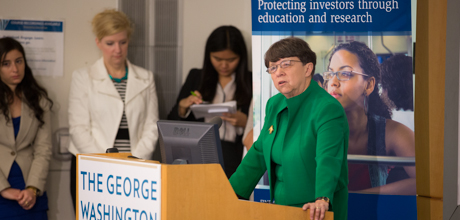By Brittney Dunkins
The George Washington University Global Center for Financial Literacy hosted the release of the 2012 Financial Capability State by State Study at the George Washington School of Business last week.
GWSB Dean Doug Guthrie welcomed the attendees, a host of financial literacy experts including Rich Ketchum, chairman and CEO of the Investor Education Foundation at the Financial Industry Regulatory Authority (FINRA); Mary Jo White, chair of the U.S. Securities and Exchange Commission (SEC); Cyrus Amir-Mokri, assistant treasury secretary for financial institutions at the U.S. Department of the Treasury; Richard Cordray, director of the Consumer Financial Protection Bureau (CFPB); and Stacey Stewart, U.S. president of United Way Worldwide, who gathered to discuss the findings and potential response strategies.
“It’s a really special opportunity to be able to do this and be a part of a conversation that brings together research, and the passion that people have for research, with real applicability,” Dr. Guthrie said.
He added a special thank you to Annamaria Lusardi, academic director of the GW Global Center for Financial Literacy and Denit Trust Distinguished Scholar in economics and accountancy, who was integral to the planning of the event.
The study, conducted by FINRA in consultation with the Department of the Treasury and the President’s Advisory Council on Financial Capability, offers analysis of the current financial literacy of Americans compared to findings from the pilot financial literacy survey given in 2009 during the height of the financial crisis.
The test population included people aged 18 to 55 and older from various ethnic, economic and educational backgrounds.
“With the 2012 study, we are seeing interesting changes in key measures of financial capability,” Mr. Ketchum said. “Some that are encouraging, and some that tell us there is a lot more work to do.”
The report assesses financial literacy based on an ability to “make ends meet” or cover basic expenses, to plan ahead for both short-term and long-term expenses, to manage financial products such as credit cards and to make sustainable decisions with basic financial knowledge.
According to Mr. Ketchum, though 40 percent of those surveyed report an ability to cover basic monthly expenses and bills, many—42 percent— still struggle with stress due to the burden of debt.
“One fascinating finding in this study is that self-reported feelings of being overwhelmed by debt changed very little across income brackets,” said Mr. Ketchum, adding that medical debt, mortgages and student loan debt caused the most stress.
The study also delved into “financial fragility,” defined as a lack of liquidity to deal with an unexpected challenge, such as a major home repair. Mr. Ketchum noted that according to the study, nearly 40 percent of all respondents reported an inability to come up with $2,000 for an unforeseen expense.
A whopping 70 percent of those in a low to moderate income bracket reported the same incapacity.
“This finding sheds light on the precarious financial situation in many U.S. households,” he said.
Additionally, the data show that the overall financial literacy between those polled in 2009 and 2012 remained the same and while 89 percent believe financial education courses should be taught in school, only a little more than 29 percent reported ever receiving instruction.
“People who have limited knowledge of the financial system are less likely to invest in the financial markets and are more unlikely to benefit from America’s economic growth,” Ms. White said. “Many Americans may needlessly struggle in retirement or miss the chance to own a home or graduate from college debt-free, all because they were never exposed to the basics of finance.”
Mr. Amir-Mokri also announced the continuation of a Treasury Department initiative in cooperation with the Financial Literacy and Education Commission that builds the skills and education of young people.
"Starting Early for Financial Success seeks to increase the number of students who know how to effectively finance higher education, increase the number of young people who prepare for retirement and increase the number of youth who have access to savings accounts, according to Mr. Amir-Mokri said.
Mr. Cordray also recommended integrated curricula in schools that include teaching the benefits of compound interest in math class, weaving economic costs and risks into social studies or assigning an English essay that explains how money is used and protected.
“People have been shaken in their deeply held belief that if they work hard and behave responsibly, they will get ahead in life and pass on a higher standard of living to their children,” Mr. Cordray said, adding that the CFPB is working with the Federal Deposit Insurance Corporation and the SEC to provide sound advice and information for managing household finances.
Ms. Stewart, offered insight into another approach to preparing Americans for the realities of the recovering economy: emphasizing the importance of savings.
She conservatively estimated $1.7 billion in refunds for those that participated in United Way’s free tax preparation program, VITA, and noted that these funds are a perfect way for many families to start saving.
“There are ways to frame savings during tax time that encourage people to take action,” she said, citing research by the University of Washington.
Following these remarks, attendees participated in a discussion with a panel including Dr. Lusardi and Gail Hillebrand, associate director of CFPB, among others.


